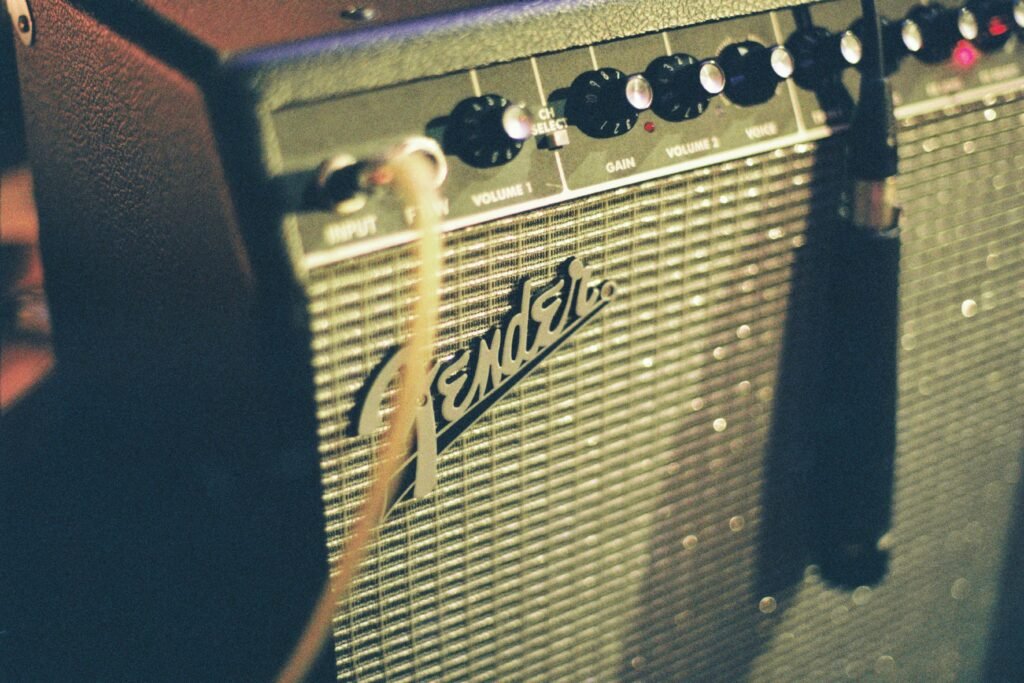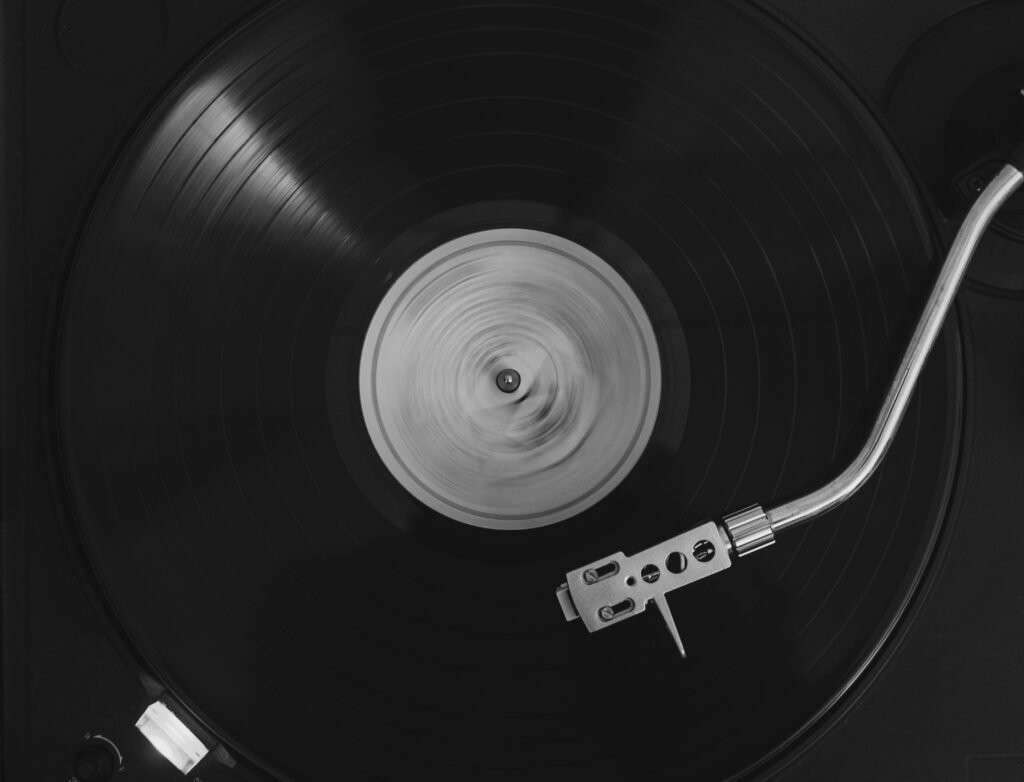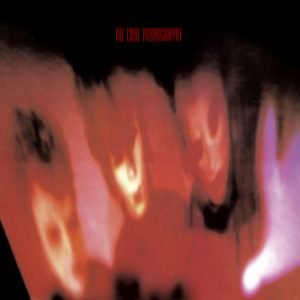Released in 1982, Pornography stands as one of The Cure’s most intense and emotionally harrowing works, marking a pivotal moment in the band’s discography. Coming off the heels of Faith (1981), which explored themes of loss and existential dread, Pornography delves even deeper into the abyss of human despair, nihilism, and isolation. This fourth studio album cemented The Cure’s status as one of the defining bands of the post-punk era, but it was also a radical departure from the relatively more accessible sound they would later cultivate.
Artistic Intentions
Musically, Pornography pushed the boundaries of the dark, brooding sonic textures that The Cure had been gradually perfecting. Whereas earlier albums like Seventeen Seconds (1980) flirted with atmospheric minimalism, Pornography embraced an almost suffocating wall of sound, with dense layers of reverb-drenched guitars, pounding drums, and Robert Smith’s haunting vocals. The album’s mood is unrelentingly bleak, reflecting a period of turmoil for both the band and Smith personally. The Cure were grappling with internal conflicts and self-destructive behavior during this era, and it manifests in the sheer emotional weight of the record.
The band’s artistic intention was clear: Pornography was meant to challenge the listener, both sonically and thematically. In interviews around the time, Robert Smith described the album as an exploration of “the ugliness of life.” It was not designed to comfort or entertain but to immerse its audience in a stark portrayal of disillusionment and mental anguish. The opening lyric, “It doesn’t matter if we all die,” sets the tone for the rest of the album, where catharsis seems perpetually out of reach. Pornography is often seen as the climax of The Cure’s so-called “goth trilogy,” representing the darkest point before the band would shift toward more melodic and pop-oriented sounds in their later work.
Sonic Exploration

The production of Pornography is as dark and uncompromising as the album’s themes, and its gritty, claustrophobic sound plays a key role in shaping its emotional intensity. Produced by The Cure and Phil Thornalley, the album leans into an intentionally lo-fi, murky aesthetic that engulfs the listener in layers of distortion, reverb, and echo. The production is not polished or pristine by any stretch—rather, it’s designed to feel oppressive, as if the music itself is trapped within the same existential weight that burdens the lyrics. The dense, shadowy production mirrors the chaotic state of mind the band was in, creating an immersive sonic experience that feels both raw and suffocating.
Musical Arrangements
This lo-fi approach is particularly effective in serving the album’s mood of despair and alienation. Instruments often bleed into one another, with Simon Gallup’s thunderous basslines and Lol Tolhurst’s tribal, relentless drumming forming a brooding backbone for the tracks. The result is a soundscape that feels almost impenetrable at times, echoing the overwhelming emotional darkness that Robert Smith conveys in his lyrics. This deliberate lack of clarity in the production forces the listener to wade through the murk, enhancing the album’s themes of confusion and inner turmoil.
Musically, the arrangements on Pornography are stark and minimal, yet incredibly impactful. The drums are often mixed prominently, creating a sense of urgency and tension, while the guitars and keyboards weave a haunting, almost hypnotic backdrop. What makes these arrangements stand out is their relentlessness—tracks like “The Hanging Garden” feature pounding, ritualistic rhythms that seem to build without resolution, creating a sense of unease that lasts throughout the entire album.
Robert Smith’s vocals, often buried under layers of effects, sound detached and ghostly, further amplifying the feeling of disconnection that permeates the record. In some moments, his voice is a mere whisper; in others, it rises into a tormented wail, but it always feels like it’s coming from a place of profound isolation.
Genre Elements
The album is deeply rooted in post-punk and gothic rock, but it also ventures into experimental territory that defies easy categorization. While Pornography stays true to the ethos of the gothic genre—its bleakness, its dark romanticism—it also incorporates elements of psychedelia, particularly in the swirling, hallucinogenic soundscapes of tracks like “Siamese Twins” and “A Strange Day.” The Cure’s use of dissonance, repetition, and feedback draws from the sonic palette of krautrock and proto-industrial music, making Pornography feel ahead of its time. This genre-blurring, especially within the more experimental edges of post-punk, would go on to influence future bands in the gothic and alternative scenes.
Lyrical Analysis

The lyrics on Pornography are an unflinching exploration of despair, alienation, and inner torment, with Robert Smith’s writing reaching some of its most bleak and introspective depths. The central themes of the album revolve around existential dread, mortality, and the crushing weight of emotional and psychological disintegration. From the opening lines of “One Hundred Years” — “It doesn’t matter if we all die” — the album plunges into a relentless exploration of nihilism, setting the stage for a lyrical journey that feels claustrophobic and inescapable. This overarching sense of hopelessness is echoed throughout the record, with recurring motifs of death, isolation, and fractured identity.
Themes
These themes are expressed through lyrics that are often abstract, more akin to fragmented poetry than linear storytelling. Rather than guiding the listener through a clear narrative, Smith’s lyrics on Pornography offer shards of emotion and thought, leaving much open to interpretation. Songs like “The Hanging Garden” and “Siamese Twins” present vivid, almost surreal images—“creatures kissing in the rain,” “In the heat of the night, the animals scream”—that suggest a world both decaying and primal.
These images evoke a dreamlike, often nightmarish atmosphere, allowing the listener to project their own meanings and emotions onto the words. This abstraction only intensifies the album’s emotional impact, as the lyrics feel less like a series of events and more like glimpses into a disturbed psyche.
Lyrically, Pornography is far from straightforward; its complexity lies in its ambiguity. Robert Smith’s use of repetition—phrases that loop, mirror, and distort—creates a feeling of obsession, as if the speaker is trapped in a cycle of self-doubt and anguish. Take, for example, the haunting refrain of “Siamese Twins”: “The world disappeared laughing into the fire/ is it always like this?” This lyrical device not only reflects the disorienting mental states of the characters but also gives the album an almost ritualistic quality. The words themselves feel like incantations, drawing the listener deeper into a space where logic unravels and all that remains is raw emotion.
Emotional Impact
The emotional impact of these lyrics is profound. Pornography does not offer solace or catharsis; instead, it forces the listener to confront uncomfortable emotions head-on. The repeated references to death, decay, and destruction evoke a powerful sense of sadness and anxiety. In “Cold,” Smith sings, “Your name like ice into my heart,” a line that, while simple on the surface, conveys a deep sense of emotional detachment and loneliness. Throughout the album, there’s a palpable tension between the desire for connection and the impossibility of achieving it—a theme that resonates with anyone who has ever felt alienated from themselves or others.
Cohesion and Flow

Pornography is a masterclass in sonic and thematic cohesion, with its tracks seamlessly flowing into one another to create an unbroken emotional journey. The album’s progression feels less like a collection of individual songs and more like a continuous descent into despair, where each track deepens the overarching mood of existential dread. From the aggressive opening of “One Hundred Years” to the slow, agonizing close of the title track, Pornography maintains a harrowing sense of momentum, drawing the listener deeper into its suffocating atmosphere with every song.
The album’s track progression mirrors an emotional arc of escalating tension and turmoil. “One Hundred Years” starts with a sense of urgency and fury, its pounding drums and jagged guitars establishing the album’s dark intensity right from the start. As the record unfolds, it gradually shifts from this visceral anger to more introspective, albeit equally unsettling, emotional territory. Songs like “The Figurehead” and “A Strange Day” feel more introspective and atmospheric, their slower tempos and haunting melodies adding to the feeling of emotional and psychological unraveling. The relentless drumming and swirling guitars create a hypnotic effect, making it difficult to separate one track from the next, which enhances the sense of being submerged in a single, overwhelming emotional state.
Thematic Consistency
Despite subtle variations in tempo and texture, the album’s thematic and sonic consistency remains unbroken throughout. Each track reinforces the same core themes of disillusionment, alienation, and internal conflict, ensuring that Pornography feels like a cohesive whole rather than a disjointed collection of songs. The recurring use of heavy, reverberating basslines, pounding percussion, and eerie, distorted guitars ensures that the album’s oppressive mood never wavers. Even when there are moments of quieter introspection, as on tracks like “Siamese Twins,” the bleak atmosphere remains intact. The lyrics, too, continue to hammer home the same motifs of loss and decay, reinforcing the unrelenting gloom that binds the album together.
There are no jarring stylistic shifts or sudden breaks in mood; instead, the album gradually intensifies its sense of doom until it reaches its bleak conclusion. The title track, “Pornography,” serves as both a culmination and a thematic resolution (or rather, lack of resolution) to the emotional journey. Its repetitive, droning instrumentation and anguished lyrics give the impression of reaching the heart of darkness, echoing back the themes of the entire record in a final, gut-wrenching declaration: “I must fight this sickness, find a cure.” In this way, the album circles back on itself, providing a haunting, cyclical feeling that leaves the listener trapped in the same emotional spiral that defined the first track.
Standout Tracks and Moments
While Pornography is best experienced as a continuous, immersive journey, several tracks stand out for their artistic depth, emotional intensity, and unique contribution to the album’s dark aesthetic. These songs, while part of a cohesive whole, offer moments of particular brilliance that encapsulate the record’s overarching themes of despair and alienation.
“One Hundred Years”
The album’s opener, “One Hundred Years,” is a visceral and uncompromising declaration of intent, setting the tone for what is to come. From the very first line, “It doesn’t matter if we all die,” the listener is plunged into Robert Smith’s apocalyptic vision. What sets this track apart is its relentless intensity—pounding drums, jagged guitars, and an undercurrent of swirling feedback create an oppressive atmosphere that mirrors the song’s lyrical nihilism.
Simon Gallup’s driving bassline anchors the track, while Smith’s vocals, drenched in reverb, convey both desperation and fury. This song is a standout not only because it introduces the album’s thematic darkness but also because of its sheer force and emotional impact, making it one of the most iconic moments in Pornography.
“The Hanging Garden”
Another key track is “The Hanging Garden,” which stands out for its tribal-like rhythms and hypnotic repetition. Lol Tolhurst’s drumming is particularly striking here, creating a driving, primal energy that propels the track forward. Lyrically, the song’s imagery of animals and nature gives it a surreal, almost mythic quality, contrasting the dense sonic landscape with vivid, symbolic references. The tension between the visceral beats and Smith’s cryptic, almost chant-like vocals makes this track one of the most memorable on the album. Its steady, relentless rhythm mirrors the emotional and psychological turmoil at the heart of Pornography and captures the album’s essence of being trapped in a cyclical, inescapable struggle.
“Siamese Twins”
“Siamese Twins” is one of the album’s most emotionally harrowing tracks, with its slow, dirge-like pace and deeply personal lyrics. The song is filled with some of the most evocative imagery on the album, including the haunting line, “The world disappeared laughing into the fire/ is it always like this?” This track stands out for its stark vulnerability and introspective nature. It captures the alienation and emotional numbness that define Pornography but in a more subdued, hauntingly beautiful way. The guitar work here, melancholic and drenched in reverb, adds to the song’s atmosphere of detachment and sorrow, making it one of the most poignant moments on the album.
“A Strange Day”
“A Strange Day” provides a brief yet profound shift in tone, offering a slightly more melodic approach compared to the rest of the album. Its shimmering guitar riff and ethereal atmosphere provide a moment of introspective reflection amidst the otherwise heavy, claustrophobic sound. However, the emotional weight is still there, with Smith’s lyrics painting a picture of existential uncertainty: “held for one moment, I remember a song. An impression of sound, then everything is gone forever” This track stands out for its ability to offer a brief glimmer of beauty and contemplation while remaining deeply rooted in the album’s themes of desolation.
Memorable Moments
The guitar riff in “A Strange Day”: This haunting, otherworldly melody contrasts with the album’s darker moments, offering a brief respite without breaking the album’s emotional cohesion.
The opening lyric of “One Hundred Years”: “It doesn’t matter if we all die” is perhaps the most iconic line on the album, instantly plunging the listener into the existential abyss that defines Pornography.
The relentless drum patterns in “The Hanging Garden”: Tolhurst’s tribal, pounding rhythms not only drive the track but also capture the primal intensity and underlying chaos that run through the album.
Artistic Contribution and Innovation

Pornography occupies a seminal place within both the gothic rock genre and the broader post-punk movement of the early 1980s. At a time when many bands in the post-punk scene were experimenting with dark, introspective sounds, The Cure took this exploration to its extreme with Pornography. The album didn’t just embrace the gloom; it submerged itself in it, setting a new standard for how bleak and intense music could be. In doing so, Pornography pushed the boundaries of what gothic rock could sound like, contributing significantly to the evolution of the genre and influencing a generation of artists who sought to tap into similar emotional depths.
Place in Genre and Industry
Within the gothic rock genre, Pornography is often regarded as a cornerstone, helping to define and solidify many of the genre’s sonic and thematic characteristics. The Cure’s earlier albums had flirted with elements of goth, but Pornography is where those ideas fully crystallized, with its dense, reverb-heavy production, despairing lyrics, and ominous atmosphere. Alongside bands like Bauhaus, Siouxsie and the Banshees, and Joy Division, The Cure became one of the definitive voices of gothic rock, and Pornography in particular stands out for its unrelenting commitment to darkness and alienation. Its place within the post-punk genre is equally important, as it expanded the sonic palette of the movement by incorporating experimental, almost avant-garde elements into its sound.
In the wider music industry, Pornography was both a defiant rejection of mainstream conventions and a bold artistic statement. At a time when new wave and synth-pop were becoming increasingly popular, The Cure veered in the opposite direction, releasing an album that was deliberately difficult, unsettling, and emotionally raw. This was not music designed for radio play or commercial success, but rather an uncompromising artistic vision that demanded its audience confront uncomfortable truths. As a result, Pornography set The Cure apart from their contemporaries and established them as a band willing to push the boundaries of what popular music could address, both sonically and thematically.
Innovation
One of the most innovative aspects of Pornography is its use of production to create an overwhelming sense of atmosphere. The album’s sound is drenched in reverb, with instruments and vocals often bleeding into each other to form a murky, impenetrable wall of sound. This production style, combined with Lol Tolhurst’s relentless, pounding drum patterns and Simon Gallup’s heavy, repetitive basslines, creates an almost claustrophobic sonic experience. The production was groundbreaking for its time, eschewing clarity and precision in favor of a more immersive, suffocating soundscape that mirrored the album’s themes of confusion and despair. This approach influenced a wave of future goth and post-punk bands, many of whom adopted similarly atmospheric production techniques to convey emotional intensity.
Lyrics
Lyrically, Pornography was also innovative in its abstract, almost fragmented approach to storytelling. While many albums of the time were rooted in more straightforward or narrative-based lyrics, Robert Smith’s writing on Pornography is cryptic and poetic, allowing for multiple interpretations. The lyrics often read like fractured snapshots of inner turmoil, with recurring motifs of death, decay, and isolation that swirl together to form a larger, more ambiguous emotional picture. This abstract approach to lyricism was ahead of its time, encouraging listeners to engage with the album on a deeper, more personal level, as the meanings of the songs remain elusive and open to interpretation.
Genres
Another key innovation lies in Pornography‘s genre-blurring tendencies. While firmly rooted in gothic rock and post-punk, the album incorporates elements of krautrock, psychedelia, and proto-industrial music, making it difficult to neatly categorize. The Cure’s use of repetitive, droning rhythms and dense sonic textures was inspired by experimental music, particularly bands like Can and Neu!, whose influence can be heard in the hypnotic, driving beats of songs like “The Hanging Garden.” By blending these genres and influences, The Cure pushed gothic rock into new, more experimental territory, expanding the possibilities for the genre.
Introspection
Finally, Pornography is innovative in its emotional scope. While many albums of the time dealt with darkness and introspection, few were as unrelenting in their focus on despair and existential crisis as this record. The emotional intensity of Pornography was groundbreaking, laying the foundation for future artists who would explore similarly raw, unsettling territory. Bands like Nine Inch Nails, Depeche Mode, and even Radiohead would go on to explore themes of alienation and mental disintegration in ways that were undoubtedly influenced by Pornography’s brutal emotional honesty.
Closing Thoughts

Pornography is a towering achievement in The Cure’s discography, and arguably one of the most intense and uncompromising albums of its era. Its strengths lie in its ability to create an immersive and cohesive world of sound and emotion, enveloping the listener in a relentless exploration of despair, alienation, and psychological disintegration. The album’s dense, atmospheric production, combined with Robert Smith’s cryptic and emotionally raw lyrics, creates an experience that is as harrowing as it is powerful. Each track serves as a piece of a larger puzzle, contributing to a unified vision that’s both claustrophobic and cathartic.
weaknesses
The album’s weakness—if it can even be considered one—is its sheer intensity, which may be overwhelming for some listeners. Pornography offers no easy answers or moments of levity; it is a deeply challenging and, at times, suffocating listen. For those unaccustomed to such emotional weight, the unrelenting darkness might be difficult to process. However, this very quality is also what makes the album so effective—it doesn’t compromise its vision in any way, making it an honest and daring artistic statement.
Place In Career
In terms of its place in The Cure’s career, Pornography represents both a culmination and a turning point. It marked the peak of the band’s gothic phase, solidifying their reputation as pioneers of the genre. However, it also signaled the end of an era, as the band would move toward more accessible, pop-oriented sounds in subsequent albums. Yet, Pornography remains a cornerstone in their catalog—a definitive work that showcases the full depth of The Cure’s emotional and artistic range.
For listeners, Pornography has the potential to be a life-changing album. Its stark depiction of inner turmoil and existential dread resonates deeply with those grappling with their own emotions, providing a mirror for feelings of isolation and despair. While it may not be for everyone, for those who connect with its intensity, the album offers a profound emotional catharsis.
Rating: 10/10
Pornography deserves a perfect 10 for its boldness, innovation, and emotional impact. It’s a record that doesn’t just stand the test of time—it challenges it, continuing to influence and inspire artists across genres. The Cure’s willingness to dive so deeply into the darkest corners of the human psyche, combined with their genre-defying musical experimentation, makes Pornography a masterpiece in its own right. It’s an album that asks a lot of its listeners, but those who are willing to take the journey will find themselves deeply affected by its raw power. This is not just one of The Cure’s finest works, but one of the most important albums in post-punk and gothic rock history.
